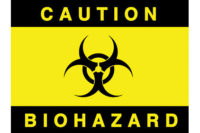Hazard communication: Be great in these 3 areas

Imagine being a worker at a jobsite. It’s your fourth day on the job and you see a myriad of compressed gas cylinders stacked on a pallet being dropped off in your work zone.
The boss, who is unavailable at the moment, mentioned ordering some nitrogen, acetylene and oxygen canisters earlier in the day, but didn’t say when they would be delivered. They are here now and the delivery driver is asking you where to unload them.
What do you do? How should you store them? Are you authorized to make this decision?
The purpose of a hazard communication program is to enhance the safety of individuals who have the potential of interacting with hazardous chemicals. It’s a straightforward effort to educate any employee that may be exposed to hazardous substances under normal working conditions or during an emergency situation.
Hazard communication (also known as HazCom) activities are regulated by the Occupational Safety and Health Administration. Core elements of a hazard program include qualification requirements, compiling a hazardous chemicals list, using safety data sheets (SDS), ensuring containers are properly labeled, providing training to employees, and making information available. Working with hazardous materials can be a very dangerous business.
Because the size and scope of the OSHA standard exceeds what we can effectively discuss here, we will focus on three areas where it pays to be great concerning a hazard communication program. By mastering these three elements, a company can ensure their hazard program is underpinned with excellent fundamentals. Keep in mind that the OSHA regulations represent the “minimum” requirements a company must meet. In at least these three areas, it pays to do much more than the minimum.
GREATNESS TRAIT #1 – KNOWING YOUR CHEMICAL HAZARDS — ALL OF THEM
Whatever the work environment is, it will always be important to know what chemical hazards are present in that workplace. Without that knowledge, a company invites health risks to their employees and subjects them to unknown threats with unknown consequences.
Each jobsite requires a hazardous chemicals list. That may sound easy to create, but its a lot more challenging than one may think. Materials such as plastic pipe and copper tubing are commonly overlooked products that manufacturers have identified as potentially hazardous. Items such as compressed air, soap and hand sanitizer may seem innocuous, but, they too, could have safety data sheets. It is alarmingly easy to have holes in your list.
Taking inventory of hazardous chemicals requires a safety professional to think outside of a product’s normal function and purpose. With plastic pipe, for example, it becomes hazardous when subjected to extreme heat. A worker may never have any need for pipe that is on fire, but that really isn’t the consideration here. What matters is if plastic pipe reaches a critical temperature, the worker needs to take notice of it and respond accordingly. Burning plastic can be a severe inhalation hazard! Anyone who bends pipe for living needs to know these things.
If unsure whether a particular chemical is hazardous, check with the manufacturer. Don’t trust this determination to a slipshod internet search. Err on the side overzealousness when considering what hazards may be present; better to cast a wide net. In this way, a company maximizes its ability to account for all the hazards onsite. That should be priority number one.
GREATNESS TRAIT #2 — TRAINING EXCELLENCE
The next area to be great is with training. For workers to be truly safe, they most know how the chemical becomes dangerous, and when/where/why those circumstances can exist at the worksite. The premium training consideration is to emphasize those hazards that are (a) the most dangerous, (b) the most frequent and (c) the least understood.
Each hazardous chemical has a safety data sheet. This information is key to informing workers of what types of hazards they could encounter. All SDS must follow the same 16-section format as outlined in the Globally Harmonized System of Classification and Labeling of Chemicals, which took effect in 2015. This makes it easy to quickly find information as each section — Section 4 on first-aid measures, for example — is the same subject matter regardless of which SDS is being reviewed.
An SDS will give you all the critical details of a hazardous chemical. It should be the foundation for any training at the jobsite. See the Toolbox Talk on the ASA website (www.asa.net) for a description of all 16 sections of an SDS.
GREATNESS TRAIT #3 – HAVE ‘BEST-IN-CLASS’ EMERGENCY RESPONSE PLANS
The third pillar of greatness for a hazard communication program is to ensure that workers know how to respond to chemical incidents that occur. It is a natural extension to the training guidance provided prior. Mastering emergency response typically includes simulations, repetition and scenario discussions. It requires collaboration, clear communication and well-defined protocols.
For this greatness trait to emerge, a company must avoid taking a “one-size-fits-all” approach to response. Each chemical is unique and the response to any hazardous incident should be treated as such.
Hazardous chemicals can have different flash points, chemical phase changes due to temperature, and a cornucopia of diverse physical and compositional characteristics. Their reactivity, what they react to, and when they react, create a unique mosaic specific to each hazardous chemical. Because of this uniqueness factor, each chemical hazard will likely require its own response plan.
Looking for a reprint of this article?
From high-res PDFs to custom plaques, order your copy today!









